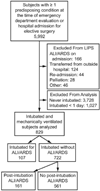Contemporary ventilator management in patients with and at risk of ALI/ARDS
- PMID: 22906363
- PMCID: PMC3840036
- DOI: 10.4187/respcare.01755
Contemporary ventilator management in patients with and at risk of ALI/ARDS
Abstract
Background: Ventilator practices in patients at risk for acute lung injury (ALI) and ARDS are unclear. We examined factors associated with choice of set tidal volumes (VT), and whether VT < 8 mL/kg predicted body weight (PBW) relates to the development of ALI/ARDS.
Methods: We performed a secondary analysis of a multicenter cohort of adult subjects at risk of lung injury with and without ALI/ARDS at onset of invasive ventilation. Descriptive statistics were used to describe ventilator practices in specific settings and ALI/ARDS risk groups. Logistic regression analysis was used to determine the factors associated with the use of VT < 8 mL/kg PBW and the relationship of VT to ALI/ARDS development and outcome.
Results: Of 829 mechanically ventilated patients, 107 met the criteria for ALI/ARDS at time of intubation, and 161 developed ALI/ARDS after intubation (post-intubation ALI/ARDS). There was significant intercenter variability in initial ventilator settings, and in the incidence of ALI/ARDS and post-intubation ALI/ARDS. The median VT was 7.96 (IQR 7.14-8.94) mL/kg PBW in ALI/ARDS subjects, and 8.45 (IQR 7.50-9.55) mL/kg PBW in subjects without ALI/ARDS (P = .004). VT decreased from 8.40 (IQR 7.38-9.37) mL/kg PBW to 7.97 (IQR 6.90-9.23) mL/kg PBW (P < .001) in those developing post-intubation ALI/ARDS. Among subjects without ALI/ARDS, VT ≥ 8 mL/kg PBW was associated with shorter height and higher body mass index, while subjects with pneumonia were less likely to get ≥ 8 mL/kg PBW. Initial VT ≥ 8 mL/kg PBW was not associated with the post-intubation ALI/ARDS (adjusted odds ratio 1.30, 95% CI 0.74-2.29) or worse outcomes. Post-intubation ALI/ARDS subjects had mortality similar to subjects intubated with ALI/ARDS.
Conclusions: Clinicians seem to respond to ALI/ARDS with lower initial VT. Initial VT, however, was not associated with the development of post-intubation ALI/ARDS or other outcomes.
Trial registration: ClinicalTrials.gov NCT00889772.
Keywords: ARDS; acute lung injury; mechanical ventilation; mortality; tidal volume.
Conflict of interest statement
The other authors have disclosed no conflicts of interest.
Figures



Comment in
-
Mechanical ventilation of patients with and without ARDS: how far have we come?Respir Care. 2013 Apr;58(4):712-4. doi: 10.4187/respcare.02384. Respir Care. 2013. PMID: 23564874 Free PMC article. No abstract available.
References
-
- Amato MB, Barbas CS, Medeiros DM, Magaldi RB, Schettino GP, Lorenzi-Filho G, et al. Effect of a protective-ventilation strategy on mortality in the acute respiratory distress syndrome. N Engl J Med. 1998;338(6):347–354. - PubMed
-
- The Acute Respiratory Distress Syndrome Network. Ventilation with lower tidal volumes as compared with traditional tidal volumes for acute lung injury and the acute respiratory distress syndrome. N Engl J Med. 2000;342(18):1301–1308. - PubMed
-
- Villar J, Kacmarek RM, Perez-Mendez L, Aguirre-Jaime A. A high positive end-expiratory pressure, low tidal volume ventilatory strategy improves outcome in persistent acute respiratory distress syndrome: a randomized, controlled trial. Crit Care Med. 2006;34(5):1311–1318. - PubMed
-
- Putensen C, Theuerkauf N, Zinserling J, Wrigge H, Pelosi P. Meta-analysis: ventilation strategies and outcomes of the acute respiratory distress syndrome and acute lung injury. Ann Intern Med. 2009;151(8):566–576. - PubMed
-
- Weinert CR, Gross CR, Marinelli WA. Impact of randomized trial results on acute lung injury ventilator therapy in teaching hospitals. Am J Respir Crit Care Med. 2003;167(10):1304–1309. - PubMed
Publication types
MeSH terms
Associated data
Grants and funding
- I01 BX001786/BX/BLRD VA/United States
- P01 HL 095491/HL/NHLBI NIH HHS/United States
- R01 HL086667/HL/NHLBI NIH HHS/United States
- K24 HL 093218/HL/NHLBI NIH HHS/United States
- R01 HL090897/HL/NHLBI NIH HHS/United States
- R01 HL085188/HL/NHLBI NIH HHS/United States
- HL084060/HL/NHLBI NIH HHS/United States
- K24 HL093218/HL/NHLBI NIH HHS/United States
- HL60710/HL/NHLBI NIH HHS/United States
- R01 HL085188-01A2/HL/NHLBI NIH HHS/United States
- P01 HL095491/HL/NHLBI NIH HHS/United States
- R01 HL084060/HL/NHLBI NIH HHS/United States
- R01 HL060710/HL/NHLBI NIH HHS/United States
LinkOut - more resources
Full Text Sources
Other Literature Sources
Medical
Miscellaneous

